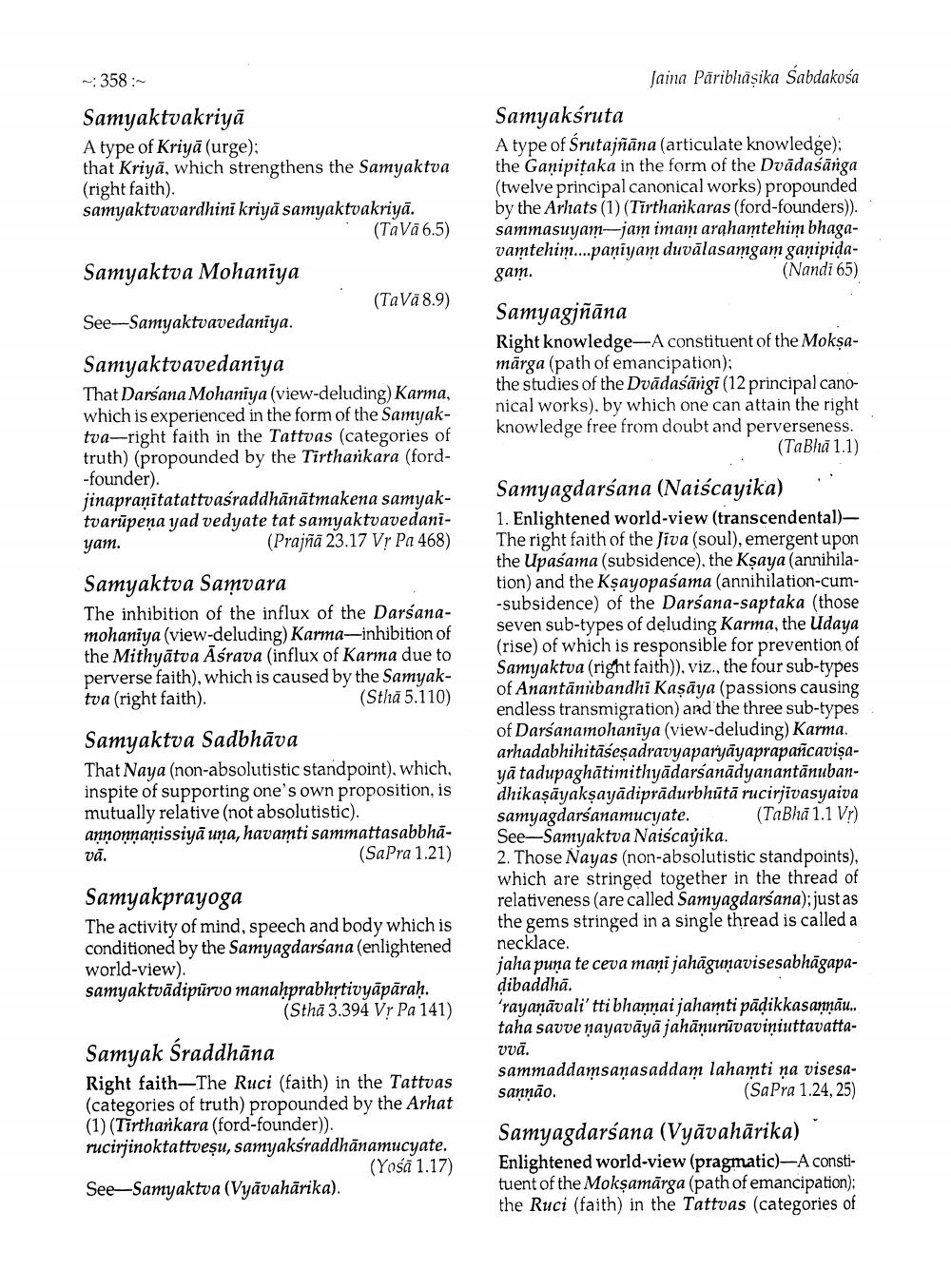________________
-: 358 :Samyaktvakriyā A type of Kriyā (urge); that Kriyā, which strengthens the Samyaktva (right faith). samyaktvavardhini kriyā samyaktvakriya.
(TaVā6.5)
Jaina Pāriblāşika Sabdakosa Samyakśruta A type of Śrutajñāna (articulate knowledge); the Ganipitaka in the form of the Dvādaśänga (twelve principal canonical works) propounded by the Arhats (1) (Tirtharkaras (ford-founders)). sammasuyam-jam imam arghamtehim bhagavamtehim....paņiyam duvālasamgam ganipidagam.
(Nandi 65)
Samyaktva Mohaniya
(TaVā8.9)
See-Samyaktvavedaniya.
Samyaktvavedaniya That Darsana Mohaniya (view-deluding) Karma, which is experienced in the form of the Samyaktva-right faith in the Tattvas (categories of truth) (propounded by the Tirtharkara (ford-founder) jinaprañitatattvasraddhānātmakena samyaktvarüpeņa yad vedyate tat samyaktvavedaniyam.
(Prajña 23.17 Vr Pa 468)
Samyagjñāna Right knowledge-A constituent of the Mokșamārga (path of emancipation); the studies of the Dvādaśārgi (12 principal canonical works), by which one can attain the right knowledge free from doubt and perverseness.
(Ta Bhā 1.1)
Samyaktva Samvara The inhibition of the influx of the Darsanamohaniya (view-deluding) Karma—inhibition of the Mithyātva Āśrava (influx of Karma due to perverse faith), which is caused by the Samyaktva (right faith).
(Sthā 5.110)
Samyaktva Sadbhāva That Naya (non-absolutistic standpoint), which, inspite of supporting one's own proposition, is mutually relative (not absolutistic). annonnanissiyā una, havamti sammattasabbhāvā.
(SaPra 1.21)
Samyagdarśana (Naiscayika) 1. Enlightened world-view (transcendental) The right faith of the Jiva (soul), emergent upon the Upasama (subsidence), the Kşaya (annihilation) and the Kşayopasama (annihilation-cum-subsidence) of the Darśana-saptaka (those seven sub-types of deluding Karma, the Udaya (rise) of which is responsible for prevention of Samyaktva (right faith)), viz., the four sub-types of Anantānubandhi Kaşāya (passions causing endless transmigration) and the three sub-types of Darśanamohaniya (view-deluding) Karma. arhadabhihitāśeşadravyaparyāyaprapancavişayā tadupaghātimithyādarśanādyanantānubandhikaṣāyakṣayādiprādurbhūtā rucirjivasyaiva samyagdarśanamucyate. (TaBhā 1.1 Vr) See-Samyaktva Naiscayika. 2. Those Nayas (non-absolutistic standpoints), which are stringed together in the thread of relativeness (are called Samyagdarśana); just as the gems stringed in a single thread is called a necklace. jaha puna te ceva mani jahāgunavisesabhāgapadibaddha. ‘rayaņāvali' tti bhannai jahamti pāờikkasannāu.. taha savve nayavāyā jahānurūvaviņiuttavattavvā. sammaddamsaņasaddam lahamti na visesasannão.
(SaPra 1.24,25)
Samyakprayoga The activity of mind, speech and body which is conditioned by the Samyagdarśana (enlightened world-view). samyaktvādipūrvo manahprabhịtivyāpāraḥ.
(Shã 3.394 VỊ Pa 141) Samyak Śraddhāna Right faith-The Ruci (faith) in the Tattvas (categories of truth) propounded by the Arhat (1) (Tirtharikara (ford-founder)). rucirjinoktattveșu, samyaksraddhānamucyate.
(Yośā 1.17) See-Samyaktva (Vyāvahārika).
Samyagdarsana (Vyāvahārika) Enlightened world-view (pragmatic)—A constituent of the Mokşamārga (path of emancipation); the Ruci (faith) in the Tattvas (categories of




